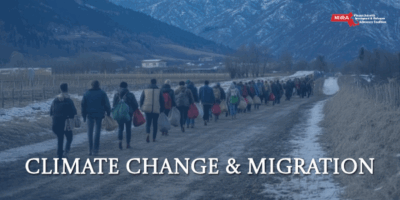
Last month was the 55th celebration of Earth Day – a global event observed annually on April 22nd to support environmental protection. Over the years, climate change has become a subject of intense political debate. Its effect on vulnerable populations, our society and our global economy and stability continues to be a challenge that directly impacts political action and policy decisions. Nonetheless, the long-term shifts in temperatures and weather patterns to the earth’s climate system is happening and we all should be concerned.
One of the most vulnerable populations that are directly affected by climate change are migrants. Climate change is a significant driver of migration, forcing a growing number of people – many who already struggle to find the basic necessities to survive – seek safer livelihoods elsewhere. According to Welcoming America’s new microsite, the Climate Migration Tool designed to equip local leaders with the tools to navigate climate migration, this displacement can be caused by “acute events such as hurricanes and wildfire, and growing climate stressors like drought, rising temperatures, and sea level rise.” Although there is a myth that climate change will amplify large-scale cross-border movements from the Global South to the Global North, “climate-related displacement is now occurring with alarming frequency both in the U.S. and across the globe, with the majority of displaced people remaining within their country’s borders.”
Climate Factors in Migration and Displacement
Intensifies pre-existing vulnerabilities:
Climate change exacerbates pre-existing vulnerabilities that drive migration (poverty, violence, persecution) and makes it more challenging for people to maintain livelihoods and adapt to changing conditions.
Uninhabitable Environments:
Climate change makes certain parts of the world less viable places to live due to climate issues such as land loss, agricultural losses, food insecurity and water scarcity.
Interaction with other factors:
Climate change can interact with other factors such as global conflicts, economic opportunities, public health and political instability. This further complicates migration patterns.
On a global scale, climate-induced migration is projected to effect millions of people, with Sub-Saharan Africa, South Asia, and Latin America being particularly vulnerable. The International Refugee Assistance Project (IRAP), Al Otro Lado, Las Americas Immigrant Advocacy Center, and Haitian Bridge Alliance has put together a powerful new report that provides definitive evidence on how climate change and environmental disasters are substantially impacting people seeking immigration relief in the United States – read it here.
The UNHCR, the UN Refugee Agency, predicts that by 2050, more than 200 million people will be forcibly displaced by extreme weather and environmental disasters. The legal status of “climate migrants” or “climate refugees” is not yet clearly defined, which raises concerns about the rights & protections for climate displaced people. To protect our communities, we must fight for climate justice!
- Join NPNA’s Climate Justice Collaborative, A national cohort of immigrant organizing partners who are developing the leadership of frontline migrant communities. View the program application here.
- Check out Welcoming America’s Climate Migration Tool equips local leaders with the tools to navigate climate migration while building more welcoming, resilient communities.
- Support POC & Immigrant-led Climate Change Organizations such as; Green Latinos, Climate Justice Alliance (CJA), Power Shift Network (PSN) and The Energy Democracy Project.
